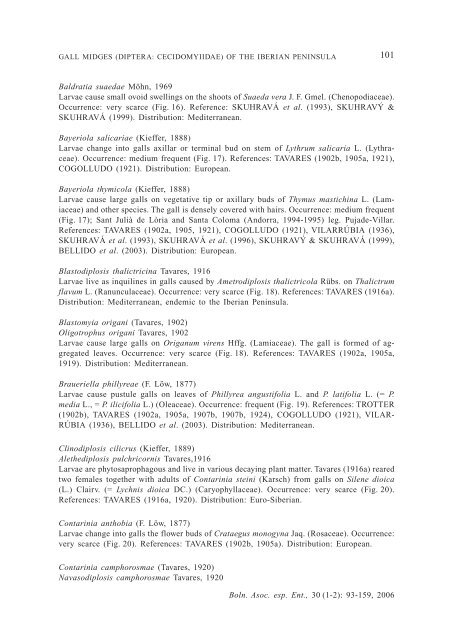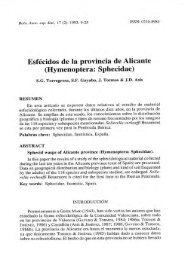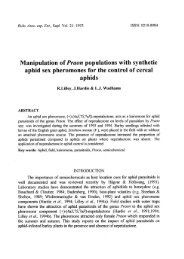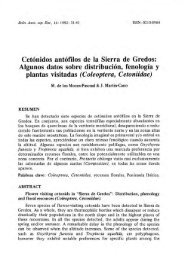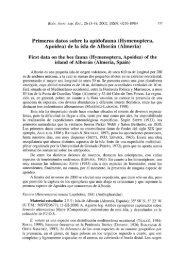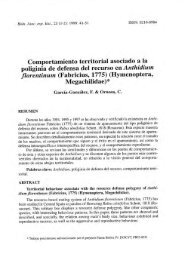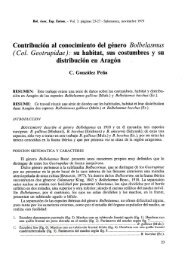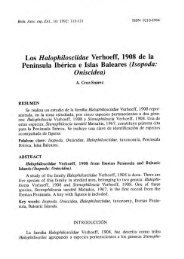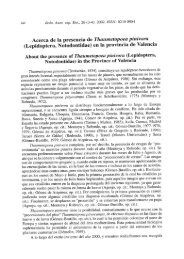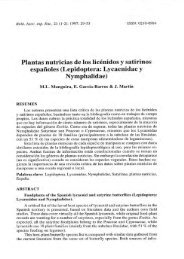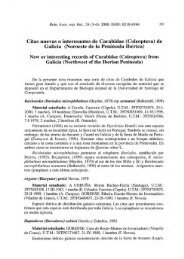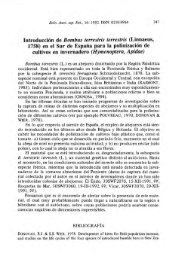Libro 1.indb
Libro 1.indb
Libro 1.indb
Create successful ePaper yourself
Turn your PDF publications into a flip-book with our unique Google optimized e-Paper software.
GALL MIDGES (DIPTERA: CECIDOMYIIDAE) OF THE IBERIAN PENINSULA 101<br />
Baldratia suaedae Möhn, 1969<br />
Larvae cause small ovoid swellings on the shoots of Suaeda vera J. F. Gmel. (Chenopodiaceae).<br />
Occurrence: very scarce (Fig. 16). Reference: SKUHRAVÁ et al. (1993), SKUHRAVÝ &<br />
SKUHRAVÁ (1999). Distribution: Mediterranean.<br />
Bayeriola salicariae (Kieffer, 1888)<br />
Larvae change into galls axillar or terminal bud on stem of Lythrum salicaria L. (Lythraceae).<br />
Occurrence: medium frequent (Fig. 17). References: TAVARES (1902b, 1905a, 1921),<br />
COGOLLUDO (1921). Distribution: European.<br />
Bayeriola thymicola (Kieffer, 1888)<br />
Larvae cause large galls on vegetative tip or axillary buds of Thymus mastichina L. (Lamiaceae)<br />
and other species. The gall is densely covered with hairs. Occurrence: medium frequent<br />
(Fig. 17); Sant Julià de Lòria and Santa Coloma (Andorra, 1994-1995) leg. Pujade-Villar.<br />
References: TAVARES (1902a, 1905, 1921), COGOLLUDO (1921), VILARRÚBIA (1936),<br />
SKUHRAVÁ et al. (1993), SKUHRAVÁ et al. (1996), SKUHRAVÝ & SKUHRAVÁ (1999),<br />
BELLIDO et al. (2003). Distribution: European.<br />
Blastodiplosis thalictricina Tavares, 1916<br />
Larvae live as inquilines in galls caused by Ametrodiplosis thalictricola Rübs. on Thalictrum<br />
flavum L. (Ranunculaceae). Occurrence: very scarce (Fig. 18). References: TAVARES (1916a).<br />
Distribution: Mediterranean, endemic to the Iberian Peninsula.<br />
Blastomyia origani (Tavares, 1902)<br />
Oligotrophus origani Tavares, 1902<br />
Larvae cause large galls on Origanum virens Hffg. (Lamiaceae). The gall is formed of aggregated<br />
leaves. Occurrence: very scarce (Fig. 18). References: TAVARES (1902a, 1905a,<br />
1919). Distribution: Mediterranean.<br />
Braueriella phillyreae (F. Löw, 1877)<br />
Larvae cause pustule galls on leaves of Phillyrea angustifolia L. and P. latifolia L. (= P.<br />
media L., = P. ilicifolia L.) (Oleaceae). Occurrence: frequent (Fig. 19). References: TROTTER<br />
(1902b), TAVARES (1902a, 1905a, 1907b, 1907b, 1924), COGOLLUDO (1921), VILAR-<br />
RÚBIA (1936), BELLIDO et al. (2003). Distribution: Mediterranean.<br />
Clinodiplosis cilicrus (Kieffer, 1889)<br />
Alethediplosis pulchricornis Tavares,1916<br />
Larvae are phytosaprophagous and live in various decaying plant matter. Tavares (1916a) reared<br />
two females together with adults of Contarinia steini (Karsch) from galls on Silene dioica<br />
(L.) Clairv. (= Lychnis dioica DC.) (Caryophyllaceae). Occurrence: very scarce (Fig. 20).<br />
References: TAVARES (1916a, 1920). Distribution: Euro-Siberian.<br />
Contarinia anthobia (F. Löw, 1877)<br />
Larvae change into galls the flower buds of Crataegus monogyna Jaq. (Rosaceae). Occurrence:<br />
very scarce (Fig. 20). References: TAVARES (1902b, 1905a). Distribution: European.<br />
Contarinia camphorosmae (Tavares, 1920)<br />
Navasodiplosis camphorosmae Tavares, 1920<br />
Boln. Asoc. esp. Ent., 30 (1-2): 93-159, 2006


